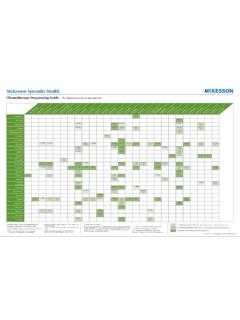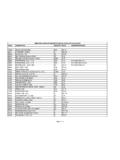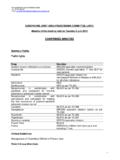Transcription of ANNEX I SUMMARY OF PRODUCT CHARACTERISTICS
1 1 ANNEX I SUMMARY OF PRODUCT CHARACTERISTICS 2 1. NAME OF THE MEDICINAL PRODUCT Avastin 25 mg/ml concentrate for solution for infusion. 2. QUALITATIVE AND QUANTITATIVE COMPOSITION Each ml of concentrate contains 25 mg of bevacizumab *. Each 4 ml vial contains 100 mg of bevacizumab . Each 16 ml vial contains 400 mg of bevacizumab . For dilution and other handling recommendations, see section * bevacizumab is a recombinant humanised monoclonal antibody produced by DNA technology in Chinese Hamster Ovary cells. For the full list of excipients, see section 3. PHARMACEUTICAL FORM Concentrate for solution for infusion. Clear to slightly opalescent, colourless to pale brown liquid. 4. CLINICAL PARTICULARS Therapeutic indications bevacizumab in combination with fluoropyrimidine-based chemotherapy is indicated for treatment of adult patients with metastatic carcinoma of the colon or rectum. bevacizumab in combination with paclitaxel is indicated for first-line treatment of adult patients with metastatic breast cancer.
2 For further information as to human epidermal growth factor receptor 2 (HER2) status, please refer to section bevacizumab in combination with capecitabine is indicated for first-line treatment of adult patients with metastatic breast cancer in whom treatment with other chemotherapy options including taxanes or anthracyclines is not considered appropriate. Patients who have received taxane and anthracycline-containing regimens in the adjuvant setting within the last 12 months should be excluded from treatment with Avastin in combination with capecitabine. For further information as to HER2 status, please refer to section bevacizumab , in addition to platinum-based chemotherapy, is indicated for first-line treatment of adult patients with unresectable advanced, metastatic or recurrent non-small cell lung cancer other than predominantly squamous cell histology. bevacizumab , in combination with erlotinib, is indicated for first-line treatment of adult patients with unresectable advanced, metastatic or recurrent non-squamous non-small cell lung cancer with Epidermal Growth Factor Receptor (EGFR) activating mutations (see Section ).
3 bevacizumab in combination with interferon alfa-2a is indicated for first line treatment of adult patients with advanced and/or metastatic renal cell cancer. bevacizumab , in combination with carboplatin and paclitaxel is indicated for the front-line treatment of adult patients with advanced (International Federation of Gynecology and Obstetrics (FIGO) stages III B, III C and IV) epithelial ovarian, fallopian tube, or primary peritoneal cancer. (See section ). 3 bevacizumab , in combination with carboplatin and gemcitabine or in combination with carboplatin and paclitaxel, is indicated for treatment of adult patients with first recurrence of platinum-sensitive epithelial ovarian, fallopian tube or primary peritoneal cancer who have not received prior therapy with bevacizumab or other VEGF inhibitors or VEGF receptor targeted agents. bevacizumab in combination with paclitaxel, topotecan, or pegylated liposomal doxorubicin is indicated for the treatment of adult patients with platinum-resistant recurrent epithelial ovarian, fallopian tube, or primary peritoneal cancer who received no more than two prior chemotherapy regimens and who have not received prior therapy with bevacizumab or other VEGF inhibitors or VEGF receptor targeted agents (see Section ).
4 bevacizumab , in combination with paclitaxel and cisplatin or, alternatively, paclitaxel and topotecan in patients who cannot receive platinum therapy, is indicated for the treatment of adult patients with persistent, recurrent, or metastatic carcinoma of the cervix (see Section ). Posology and method of administration Avastin must be administered under the supervision of a physician experienced in the use of antineoplastic medicinal products. Posology Metastatic carcinoma of the colon or rectum (mCRC) The recommended dose of Avastin, administered as an intravenous infusion, is either 5 mg/kg or 10 mg/kg of body weight given once every 2 weeks or mg/kg or 15 mg/kg of body weight given once every 3 weeks. It is recommended that treatment be continued until progression of the underlying disease or until unacceptable toxicity. Metastatic breast cancer (mBC) The recommended dose of Avastin is 10 mg/kg of body weight given once every 2 weeks or 15 mg/kg of body weight given once every 3 weeks as an intravenous infusion.
5 It is recommended that treatment be continued until progression of the underlying disease or until unacceptable toxicity. Non-small cell lung cancer (NSCLC) First-line treatment of non-squamous NSCLC in combination with platinum-based chemotherapy Avastin is administered in addition to platinum-based chemotherapy for up to 6 cycles of treatment followed by Avastin as a single agent until disease progression. The recommended dose of Avastin is mg/kg or 15 mg/kg of body weight given once every 3 weeks as an intravenous infusion. Clinical benefit in NSCLC patients has been demonstrated with both mg/kg and 15 mg/kg doses (see section ). It is recommended that treatment be continued until progression of the underlying disease or until unacceptable toxicity. First-line treatment of non-squamous NSCLC with EGFR activating mutations in combination with erlotinib EGFR mutation testing should be performed prior to initiation of treatment with the combination of Avastin and erlotinib.
6 It is important that a well-validated and robust methodology is chosen to avoid false negative or false positive determinations. 4 The recommended dose of Avastin when used in addition to erlotinib is 15 mg/kg of body weight given once every 3 weeks as an intravenous infusion. It is recommended that the treatment with Avastin in addition to erlotinib is continued until disease progression. For the posology and method of administration of erlotinib, please refer to the full erlotinib prescribing information. Advanced and/or metastatic renal cell cancer (mRCC) The recommended dose of Avastin is 10 mg/kg of body weight given once every 2 weeks as an intravenous infusion. It is recommended that treatment be continued until progression of the underlying disease or until unacceptable toxicity. Epithelial ovarian, fallopian tube and primary peritoneal cancer Front-line treatment: Avastin is administered in addition to carboplatin and paclitaxel for up to 6 cycles of treatment followed by continued use of Avastin as single agent until disease progression or for a maximum of 15 months or until unacceptable toxicity, whichever occurs earlier.
7 The recommended dose of Avastin is 15 mg/kg of body weight given once every 3 weeks as an intravenous infusion. Treatment of platinum-sensitive recurrent disease: Avastin is administered in combination with either carboplatin and gemcitabine for 6 cycles and up to 10 cycles or in combination with carboplatin and paclitaxel for 6 cycles and up to 8 cycles, followed by continued use of Avastin as single agent until disease recommended dose of Avastin is 15 mg/kg of body weight given once every 3 weeks as an intravenous infusion. Treatment of platinum-resistant recurrent disease: Avastin is administered in combination with one of the following agents paclitaxel, topotecan (given weekly) or pegylated liposomal doxorubicin. The recommended dose of Avastin is 10 mg/kg of body weight given once every 2 weeks as an intravenous infusion. When Avastin is administered in combination with topotecan (given on days 1-5, every 3 weeks), the recommended dose of Avastin is 15 mg/kg of body weight given once every 3 weeks as an intravenous infusion.
8 It is recommended that treatment be continued until disease progression or unacceptable toxicity (see section , study MO22224). Cervical Cancer Avastin is administered in combination with one of the following chemotherapy regimens: paclitaxel and cisplatin or paclitaxel and topotecan. The recommended dose of Avastin is 15 mg/kg of body weight given once every 3 weeks as an intravenous infusion. It is recommended that treatment be continued until progression of the underlying disease or until unacceptable toxicity (see section ). Special populations Elderly patients: No dose adjustment is required in the elderly. Patients with renal impairment: The safety and efficacy have not been studied in patients with renal impairment (see section ). Patients with hepatic impairment: The safety and efficacy have not been studied in patients with hepatic impairment (see section ). 5 Paediatric population The safety and efficacy of bevacizumab in children less than 18 years old have not been established.
9 Currently available data are described in sections , and but no recommendation on a posology can be made. There is no relevant use of bevacizumab in the paediatric population in the indications for treatment of cancers of the colon, rectum, breast, lung, ovarian, fallopian tube, peritoneum, cervix and kidney. Method of administration The initial dose should be delivered over 90 minutes as an intravenous infusion. If the first infusion is well tolerated, the second infusion may be administered over 60 minutes. If the 60-minute infusion is well tolerated, all subsequent infusions may be administered over 30 minutes. It should not be administered as an intravenous push or bolus. Dose reduction for adverse reactions is not recommended. If indicated, therapy should either be permanently discontinued or temporarily suspended as described in section Precautions to be taken before handling or administering the medicinal PRODUCT For instructions on dilution of the medicinal PRODUCT before administration, see section Avastin infusions should not be administered or mixed with glucose solutions.
10 This medicinal PRODUCT must not be mixed with other medicinal products except those mentioned in section Contraindications Hypersensitivity to the active substance or to any of the excipients listed in section Hypersensitivity to Chinese Hamster Ovary (CHO) cell products or other recombinant human or humanised antibodies. Pregnancy (see section ). Special warnings and precautions for use In order to improve the traceability of biological medicinal products, the trade name and the batch number of the administered PRODUCT should be clearly recorded (or stated) in the patient file. Gastrointestinal (GI) perforations and Fistulae (see section ) Patients may be at an increased risk for the development of gastrointestinal perforation and gall bladder perforation when treated with Avastin. Intra-abdominal inflammatory process may be a risk factor for gastrointestinal perforations in patients with metastatic carcinoma of the colon or rectum, therefore, caution should be exercised when treating these patients.
















